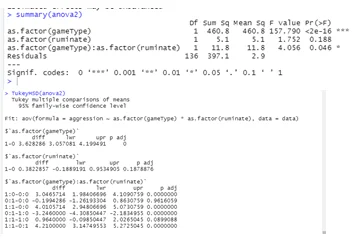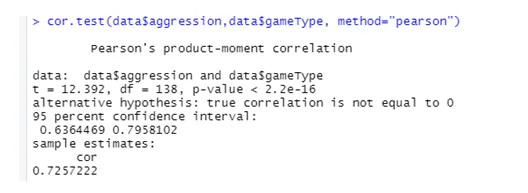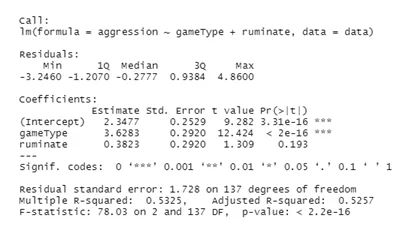Problem Description:
This study with a focus on R programming assignment aims to investigate whether video game type and rumination levels have a significant impact on aggressiveness. The theoretical basis for this exploration is rooted in the Cognitive No Linkage Theory, suggesting that rumination can perpetuate aggressive thoughts and behaviors. To assess the significance, an ANOVA test is conducted to determine the main and interaction effects. The study also highlights the potential influence of violent video games on aggression and the long-lasting effects of rumination.
Solution
- Code included to import data
- Code included to label factors
- Code For Rumination Labels factors
- Histogram
data<-read.csv("C:/Users/dell/Desktop/2021/aggression.csv")
data
For GameType
data$gameType <- factor(data$gameType,
levels = c(0,1),
labels = c("nonviolent", "violent"))
data$gameType
data$ruminate <- factor(data$ruminate ,
levels = c(0,1),
labels = c("No", "Yes"))
data$ruminate
hist(data$aggression) Purpose of the study
There are theoretical grounds to believe they do, mainly if the game's violence is a source of obsession for the players. According to cognitive no-linkage theory, rumination can keep aggressive thoughts, attitudes, and behavioral tendencies active in semantic memory over lengthy periods. It was determined how much behavioral hostility there was. We predicted the highest degrees of cognitive no-association theory. To determine the main effects and interaction term effect, estimate the ANOVA test. Video games offer a platform for learning and practicing aggressive dispute-resolution techniques. Playing violent video games seems to raise aggression. Ruminate impacts are also likely to be long-lasting; meanwhile, the participant learns and performs new aggression-related scripts that can develop progressively as interval goes on.
Hypothesis
Ho: There is no relationship between game type and rumination levels of aggressiveness.
Ha: There is a relationship between game type and rumination levels of aggressiveness.
Ho: The main effect (game type) is not significantly related to aggression.
Ha: The main effect (game type) is significantly related to aggression.
Ho: The main effect (rumination) is not significantly related to aggression.
Ha: The main effect (rumination) is significantly related to aggression.
Ho: The interaction effect (rumination*gameType) is not significantly related to aggression.
Ha: The interaction effect (rumination*gameType) is significantly related to aggression.
Purpose of hypothesis
The relationship between trait anger and anger rumination was found to predict initial levels of aggressiveness (i.e., intercept) and changes in aggression over the game type and ruminant type (i.e., slope).
Research Question
Are the main or interaction effects significant between aggression and rumination and game type?
Is there a relationship between ruminating to anger exhibit and relational aggression game type?
Type of analysis with justification.
Output
.webp)
.webp)
The above results showed the descriptive statistics of the variables. Also, describe its mean and standard deviation. The mean and the standard deviation for the variable aggression are (M = 4.353, SD = 2.5088).
Results
Figure 1

Violent games exhibited greater violence ratings than nonviolent games, according to a 2 (Game Type) x 2 (Rumination) ANOVA, F(1, 136) = 157.79, p=.0001. There were no other significant main or interaction effects. F(1, 136) = 1.752, p=0.188, that violent games had greater violence ratings than nonviolent games. Rumination has a large major effect.
Figure 2

According to Pearson correlations, there was a significant positive link between variables (r(138) =.7257, p=0.000). This implies a positive relationship between aggression and game type. When the game-type values rise, the aggression levels tend to climb as well (move right).
Figure 3

A linear regression analysis was used to see if aggression had any bearing on the game type and ruminate. The regression results showed that the model described the variation and statistically significant F (2, 137) = 78.03, p=.0000. Hence, the model is aggression =2.3477 +3.6283*game type + 0.3823*ruminate.
Graph and table
Figure 4

This pattern implies that many data points are higher than the mean, possibly outliers. As a result, the histogram plainly shows that it has a peak in the center, indicating that the aggression variable's distribution is approximately normal.